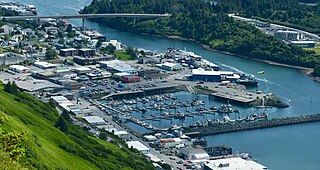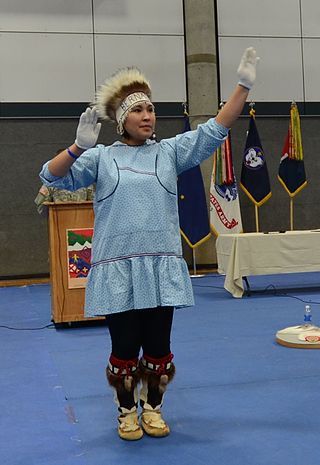
The Pribilof Islands are a group of four volcanic islands off the coast of mainland Alaska, in the Bering Sea, about 200 miles (320 km) north of Unalaska and 200 miles (320 km) southwest of Cape Newenham. The islands are part of the Alaska Maritime National Wildlife Refuge. The Siberian coast is roughly 500 miles (800 km) northwest. About 77 square miles (200 km2) in total area, they are mostly rocky and are covered with tundra, with a population of 572 as of the 2010 census.

From 1732 to 1867, the Russian Empire laid claim to northern Pacific Coast territories in the Americas. Russian colonial possessions in the Americas are collectively known as Russian America. It consisted mostly of present-day Alaska in the United States, but also included the outpost of Fort Ross in California, and three forts in Hawaii, including Russian Fort Elizabeth. Russian Creole settlements were concentrated in Alaska, including the capital, New Archangel (Novo-Arkhangelsk), which is now Sitka.

The Bering Sea is a marginal sea of the Northern Pacific Ocean. It forms, along with the Bering Strait, the divide between the two largest landmasses on Earth: Eurasia and the Americas. It comprises a deep water basin, which then rises through a narrow slope into the shallower water above the continental shelves. The Bering Sea is named after Vitus Bering, a Danish navigator in Russian service, who, in 1728, was the first European to systematically explore it, sailing from the Pacific Ocean northward to the Arctic Ocean.

St. Paul is a city in the Aleutians West Census Area, Alaska, United States. It is the main settlement of Saint Paul Island in the Pribilofs, a small island group in the Bering Sea. The population was 413 at the 2020 census, down from 479 in 2010. Saint Paul Island is known as a birdwatching haven.

The City of Kodiak is the main city and one of seven communities on Kodiak Island in Kodiak Island Borough, Alaska. All commercial transportation between the island's communities and the outside world goes through this city via ferryboat or airline. As of the 2020 census, the population of the city is 5,581, down from 6,130 in 2010. It is the tenth-largest city in Alaska.

St. Lawrence Island is located west of mainland Alaska in the Bering Sea, just south of the Bering Strait. The village of Gambell, located on the northwest cape of the island, is 50 nautical miles from the Chukchi Peninsula in the Russian Far East. The island is part of Alaska, but closer to Russia and Asia than to the Alaskan and North American mainland. St. Lawrence Island is thought to be one of the last exposed portions of the land bridge that once joined Asia with North America during the Pleistocene period. It is the sixth largest island in the United States and the 113th largest island in the world. It is considered part of the Bering Sea Volcanic Province. The Saint Lawrence Island shrew is a species of shrew endemic to St. Lawrence Island. The island is jointly owned by the predominantly Siberian Yupik villages of Gambell and Savoonga, the two main settlements on the island.

Alaska Natives are the Indigenous peoples of Alaska and include Iñupiat, Yupik, Aleut, Eyak, Tlingit, Haida, Tsimshian, and a number of Northern Athabaskan cultures. They are often defined by their language groups. Many Alaska Natives are enrolled in federally recognized Alaska Native tribal entities, who in turn belong to 13 Alaska Native Regional Corporations, who administer land and financial claims.

Bristol Bay is the easternmost arm of the Bering Sea, at 57° to 59° North 157° to 162° West in Southwest Alaska. Bristol Bay is 400 km (250 mi) long and 290 km (180 mi) wide at its mouth. A number of rivers flow into the bay, including the Cinder, Egegik, Igushik, Kvichak, Meshik, Nushagak, Naknek, Togiak, and Ugashik.

St. Matthew Island is an uninhabited, remote island in the Bering Sea in Alaska, 183 miles (295 km) west-northwest of Nunivak Island. The entire island's natural scenery and wildlife is protected as it is part of the Bering Sea unit of the Alaska Maritime National Wildlife Refuge.

The history of Alaska dates back to the Upper Paleolithic period, when foraging groups crossed the Bering land bridge into what is now western Alaska. At the time of European contact by the Russian explorers, the area was populated by Alaska Native groups. The name "Alaska" derives from the Aleut word Alaxsxaq, meaning "mainland".
The Alaska Native Regional Corporations were established in 1971 when the United States Congress passed the Alaska Native Claims Settlement Act (ANCSA) which settled land and financial claims made by the Alaska Natives and provided for the establishment of 13 regional corporations to administer those claims.

Southwest Alaska is a region of the U.S. state of Alaska. The area is not exactly defined by any governmental administrative region(s); nor does it always have a clear geographic boundary.

Hybrid power are combinations between different technologies to produce power.
Bering Straits Native Corporation (BSNC) was formed in 1972 as the Alaska Native Claims Settlement Act (ANCSA) regional corporation for the Bering Straits and Norton Sound region. The corporation actively pursues responsible development of resources and other business opportunities. Through its subsidiaries, BSNC serves the federal government and commercial customers.

Alaska occupies the northwestern portion of the North American continent and is bordered only by Canada on the east. It is one of two U.S. states not bordered by another state; Hawaii is the other. Alaska has more ocean coastline than all of the other U.S. states combined. About 500 miles (800 km) of Canadian territory separate Alaska from Washington state. Alaska is thus an exclave of the United States that is part of the continental U.S. and the U.S. West Coast, but is not part of the contiguous U.S.

FV Alaska Ranger was a fishing factory ship owned and operated by the Fishing Company of Alaska of Seattle, Washington. The ship was constructed in 1973 for use as an oil field service vessel. The ship sank 23 March 2008, after reporting progressive flooding only hours earlier. Of the 47 on board, 42 were rescued. Of the five fatalities, four were recovered dead, and one was never found. The Coast Guard was initially misinformed about the number of persons on board the vessel, and secured the search with one crew member still unaccounted for. After realizing there was still one person missing, the Coast Guard reinstated the search, but did not find the crew member.

As of April 2020, the energy sector in Senegal has an installed capacity of 1431 megawatts (MW). Energy is produced by private operators and sold to the Senelec energy corporation. According to a 2020 report by the International Energy Agency, Senegal had nearly 70% of the country connected to the national grid. Current government strategies for electrification include investments in off-grid solar and connection to the grid.

The Aleutian Islands, also called the Aleut Islands or Aleutic Islands and known before 1867 as the Catherine Archipelago, are a chain of 14 large volcanic islands and 55 smaller islands. Most of the Aleutian Islands belong to the U.S. state of Alaska, but some belong to the Russian federal subject of Kamchatka Krai. They form part of the Aleutian Arc in the Northern Pacific Ocean, occupying a land area of 6,821 sq mi (17,666 km2) and extending about 1,200 mi (1,900 km) westward from the Alaska Peninsula toward the Kamchatka Peninsula in Russia, and act as a border between the Bering Sea to the north and the Pacific Ocean to the south. Crossing longitude 180°, at which point east and west longitude end, the archipelago contains both the westernmost part of the United States by longitude and the easternmost by longitude. The westernmost U.S. island in real terms, however, is Attu Island, west of which runs the International Date Line. While nearly all the archipelago is part of Alaska and is usually considered as being in the "Alaskan Bush", at the extreme western end, the small, geologically related Commander Islands belong to Russia.

Enel Green Power S.p.A. is an Italian multinational renewable energy corporation, headquartered in Rome. The company was formed as a subsidiary of the power generation firm Enel in December 2008. It has operations in five continents generating energy from solar, geothermal, wind and hydropower sources. As of 2022, it manages a capacity of 60,9 GW and has over 1200 plants worldwide.

Wind power in Alaska has the potential to provide all of the electricity used in the U.S. state of Alaska. From its installation, in July 2009 through October 2012, the Pillar Mountain Wind 4.5 MW wind farm has saved the use of nearly 3,000,000 US gallons (11,000,000 L) of diesel fuel in Kodiak, Alaska.

















